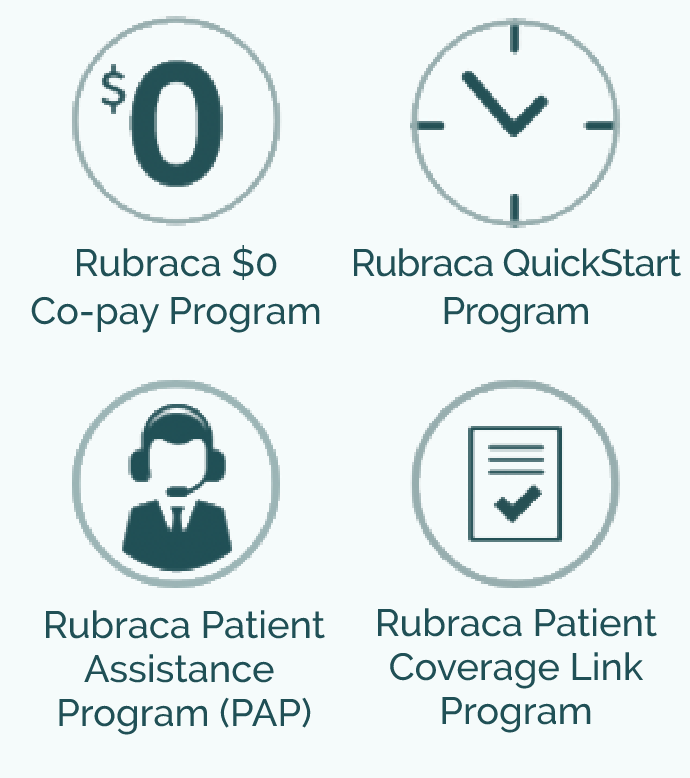
Rubraca® (rucaparib) tablets
are available today
and will be tomorrow
Rubraca® (rucaparib) tablets are now owned by pharmaand GmbH (pharma&). pharma& recognizes the importance of starting and continuing your eligible patients' treatment with Rubraca. We are committed to ensuring uninterrupted product supply to healthcare professionals and their patients, and all strengths of Rubraca are and will remain available in the United States. pharma& is dedicated to providing seamless access to Rubraca and all of our products.
Rubraca May Be Right for Your Patients

Second-Line Maintenance Treatment of Recurrent BRCAmut+ Ovarian Cancer
Maintenance treatment of adult patients with a deleterious BRCA mutation (germline and/or somatic)–associated recurrent epithelial ovarian, fallopian tube, or primary peritoneal cancer who are in a complete or partial response to platinum-based chemotherapy.



BRCAmut+ mCRPC
Treatment of adult patients with a deleterious BRCA mutation (germline and/or somatic)–associated metastatic castration-resistant prostate cancer (mCRPC) who have been treated with androgen receptor–directed therapy and a taxane-based chemotherapy. Select patients for therapy based on an FDA-approved companion diagnostic for Rubraca.
Committed to Supporting Your Patients
Throughout Their Treatment Journey
Download and complete the Rubraca Enrollment and Comprehensive Support Form and fax it to
1-844-779-7717.
Help document your patient’s medical need for treatment to gain coverage and download the Rubraca Letter of Medical Necessity.


To Order Rubraca
On May 2, 2023, Summit SD became the exclusive United States distributor of Rubraca.
You may report adverse events to the FDA at 1-800-FDA-1088 or www.fda.gov/medwatch.
You may also report adverse events or product complaints to pharma& at 1-800-506-8501 or pv@pharmaand.com.
For medical information inquiries, contact pharma& at 1-800-506-8501 or medinfo@pharmaand.com.
For questions outside of adverse event reporting, product complaints, or medical information inquiries, contact pharma& at contact@pharmaand.com.
BRCA, breast cancer susceptibility gene; BRCAmut+, BRCA-mutation positive, which includes mutations in the BRCA1 and/or BRCA2 gene; PARP, poly(ADP-ribose) polymerase.
INDICATIONS
Rubraca is indicated:
- for the maintenance treatment of adult patients with a deleterious BRCA mutation (germline and/or somatic)-associated recurrent epithelial ovarian, fallopian tube, or primary peritoneal cancer, who are in a complete or partial response to platinum-based chemotherapy.
- for the treatment of adult patients with a deleterious BRCA mutation (germline and/or somatic)-associated metastatic castration-resistant prostate cancer (mCRPC) who have been treated with androgen receptor-directed therapy and a taxane-based chemotherapy. Select patients for therapy based on an FDA-approved companion diagnostic for RUBRACA.
This indication is approved under accelerated approval based on objective response rate and duration of response. Continued approval for this indication may be contingent upon verification and description of clinical benefit in confirmatory trials.

SELECT IMPORTANT SAFETY INFORMATION
Myelodysplastic Syndrome (MDS)/Acute Myeloid Leukemia (AML) have occurred in patients treated with Rubraca, and are potentially fatal adverse reactions. In 1594 treated patients with ovarian cancer, MDS/AML occurred in 32 patients (2%), including those in long term follow-up. Of these, 14 occurred during treatment or during the 28-day safety follow-up (0.9%). The duration of Rubraca treatment prior to the diagnosis of MDS/AML ranged from < 2 months to approximately 72 months. The cases were typical of secondary MDS/cancer therapy-related AML; in all cases, patients had received previous platinum-containing chemotherapy regimens and/or other DNA damaging agents. In ARIEL3, of patients with a germline and/or somatic BRCA mutation treated with Rubraca, MDS/AML occurred in 9 out of 129 (7%) patients treated with Rubraca and 4 out of 66 (6%) patients treated with placebo. The duration of therapy with Rubraca in patients who developed secondary MDS/cancer therapy-related AML varied from 1.2 to 4.7 years.
In TRITON2, MDS/AML was not observed in patients with mCRPC (n=209) regardless of homologous recombination deficiency (HRD) mutation.
Do not start Rubraca until patients have recovered from hematological toxicity caused by previous chemotherapy (≤ Grade 1). Monitor complete blood counts for cytopenia at baseline and monthly thereafter for clinically significant changes during treatment. For prolonged hematological toxicities (> 4 weeks), interrupt Rubraca or reduce dose and monitor blood counts weekly until recovery. If the levels have not recovered to Grade 1 or less after 4 weeks or if MDS/AML is suspected, refer the patient to a hematologist for further investigations, including bone marrow analysis and blood sample for cytogenetics. If MDS/AML is confirmed, discontinue Rubraca.
Rubraca can cause fetal harm when administered to a pregnant woman based on its mechanism of action and findings from animal studies. Apprise pregnant women of the potential risk to a fetus. Advise females of reproductive potential to use effective contraception during treatment and for 6 months following the last dose of Rubraca.
For males on Rubraca treatment who have female partners of reproductive potential or who are pregnant, effective contraception should be used during treatment and for 3 months following the last dose of Rubraca. Advise male patients on Rubraca treatment, who have female partners of reproductive potential or who are pregnant to use effective contraception during treatment and for 3 months following the last dose of Rubraca.
Most common adverse reactions in ARIEL3 (≥ 20%; Grade 1-4) were nausea (79%), fatigue/asthenia (74%), abdominal pain/distention (48%), rash (45%), dysgeusia (33%), anemia (41%), AST/ALT elevation (33%), constipation (39%), vomiting (37%), diarrhea (34%), thrombocytopenia (35%), nasopharyngitis/upper respiratory tract infection (29%), stomatitis (28%), decreased appetite (23%), and neutropenia (22%).
Most common adverse reactions in TRITON2 (≥ 20%; Grade 1-4) were fatigue/asthenia (62%), nausea (52%), anemia (43%), AST/ALT elevation (33%), decreased appetite (28%), rash (27%), constipation (27%), thrombocytopenia (25%), vomiting (22%), and diarrhea (20%).
Concomitant administration of Rubraca with CYP1A2, CYP3A, CYP2C9, or CYP2C19 substrates can increase the systemic exposure of these substrates, which may increase the frequency or severity of adverse reactions of these substrates. If concomitant administration is unavoidable between Rubraca and substrates of these enzymes where minimal concentration changes may lead to serious adverse reactions decrease the substrate dosage in accordance with the approved prescribing information. If co-administration with warfarin (a CYP2C9 substrate) cannot be avoided, consider increasing frequency of international normalized ratio (INR) monitoring.
Because of the potential for serious adverse reactions in breast-fed children from Rubraca, advise lactating women not to breastfeed during treatment with Rubraca and for 2 weeks after the last dose.
You may report side effects to the FDA at 1-800-FDA-1088 or www.fda.gov/medwatch. You may also report side effects to pharma& at 1-800-506-8501.
Please see full Prescribing Information for additional Important Safety Information.